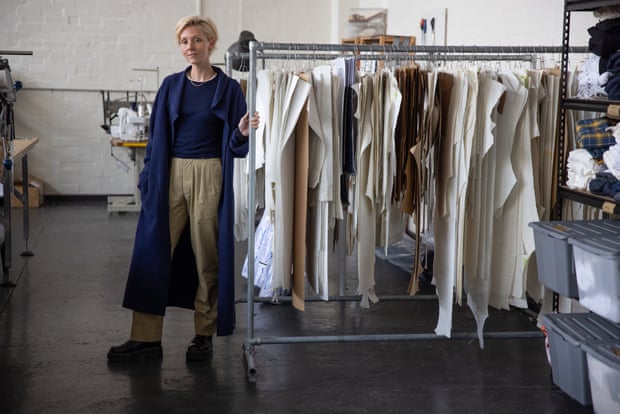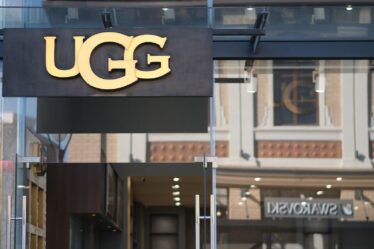
“I never fit into clothing that I wanted to wear,” says fashion designer Emily Nolan, “I found the shopping process incredibly tedious.” It was this feeling that prompted her to launch her own line of made-to-measure suits. Almost five years later, her brand, E Nolan, is one of a growing number of Australian fashion labels embracing customised and on-demand production as a novel way of doing business.
Made-to-order and made-to-measure models allow designers to circumvent some of the more challenging aspects of running a fashion brand. They reduce (or in some cases eliminates) excess stock; allow designers to avoid the financial pressure of putting several collections a year into production; and mean they can make clothes for a more diverse range of customers.
For Nolan, the process begins with a client consultation that lets her find out what the customer needs from her garments. She says made-to-measure allows her to make “garments for the body and for the client’s life” – things she describes as being the “crux of a good product” that have been “diluted” by current ready-to-wear clothing.
During last month’s Australian fashion week, Sydney designer Gary Bigeni announced the collection he was showing would only be available on a made-to-order basis. This is slightly different from made-to-measure as although Bigeni’s pieces can be customised, they are bought from a size range rather than made to individual measurements.
He says working this way allows him to connect more with his customers by taking their requests for customisation and knowing what styles, sizes and colours they order.
Both models are quite a departure from the pervasiveness of fast fashion that capitalises on a consumer desire for immediacy. Bigeni’s process takes a couple of weeks because he is making everything in-house, while Nolan’s can take up to two months, as her patterns are cut in Melbourne but her workshop is currently in Suzhou, China.
As such, they rely on a clientele that have the patience to wait for their clothes to be made and are invested in the idea that they are buying something original. “It’s made specifically for you, so it’s completely individual,” Bigeni says. “Not all pieces look the same.”
For both Nolan and Bigeni, this individualisation means they can cater to a broader range of body shapes and types, which is important in an industry that has a complicated relationship with diversity.
Nolan says for some of her clients it is the first time they have “complete control” over what they’re wearing. They can choose “the exact fabric they want, the colour they want and design the fit”, making it a “wonderful vehicle for women, non-binary people and the LGBTQ+ community”.
She says 60% of her revenue comes from selling sizes 14 and 16. Incidentally, according to the Australian Bureau of Statistics, this is the average size of women in Australia even though many of the brands that presented collections during Australian fashion week don’t make clothes over a size 12.

According to Courtney Holm, the founder of Melbourne label A.BCH, “the standard sizing system is flawed and doesn’t account for the shapes, sizes, heights, accessibility or other preferences that I see on a regular basis”.
A.BCH offers made-to-order on an extended size range that doesn’t have any restrictions. “We have customers who’ve never owned a button-up shirt before they found us because in their entire life not one shirt had ever fit them right,” she says.
In the five years since the label was founded, Holm has slowly brought production in-house, which has allowed her to introduce something she calls “just-in-time” manufacturing. “This means we can hold a small level of stock for cut-sew-knitwear and top up with small production runs as they sell … while making our higher price point and tailored pieces to order,” she says. “We can also customise any in-stock piece and make it on demand.”
Operating this way means any excess stock held by the brand is minimal, which can be a huge advantage for small businesses. Overproduction and the resulting excess are an ongoing problem for the fashion industry. Some of the biggest brands in the world, like Burberry and H&M have been caught burning stock rather than discounting it further or donating it to charity. The problem is so rife that in January 2020 France brought in a law banning the destruction of unsold products.
For small brands, excess stock can present a challenge. Holm says, from a cashflow perspective, she much prefers excess fabric over unsold finished garments. “I can make anything with that fabric in the future. Once it’s tied up in garment stock, it’s a lot harder to deal with should a style not sell as well as I hoped.”
Bigeni says making to order has allowed him to reduce waste. It is a departure from the traditional model where stores would place big orders for his designs and he would produce “boxes and boxes of stock” not knowing whether any of it would sell.

Bigeni describes this way of doing business as “sizing everything down”. Previously he was making multiple collections per year at a great expense. Operating a made-to-order model allows him to “be really realistic about my options and my decisions and grow naturally and organically” without overextending.
However, making to order removes some of the cost advantages of mass production like bulk fabric cutting. The prices of made-to-measure and customised garments also reflect the time it takes to consult with customers and construct each garment accordingly.
Bigeni’s prices start at $170 and range up to $465. You can get an A.BCH tank top for $95, while the most expensive piece on the website is a trench coat for $990, although most products sit down the lower end of that range. An E Nolan suit will set you back at least $1,700, with pants costing from $550 and a jacket $1,150.
Internationally, there are platforms that have launched made-to-order at scale. The menswear brand Proper Cloth uses digital tools to allow customers to design and order their own styles that are manufactured in Vietnam. And womenswear label Fame and Partners offers garments that are customisable through their website.
Nolan acknowledges the product is expensive but says “I’m trying to reignite the idea of return on investment and cost per wear”. She says she wears each of her trousers at least once or twice a week, and that she’s had some of them for four years.
Figuring out how to make made-to-order more accessible is something Bigeni, who is also a part-time youth worker, thinks about too. “I totally understand that someone has to have money to have the made-to-order experience,” he says, “I’m always thinking about ways to improve and make it more feasible to customers. I don’t want it to be a boutique kind of thing.”



